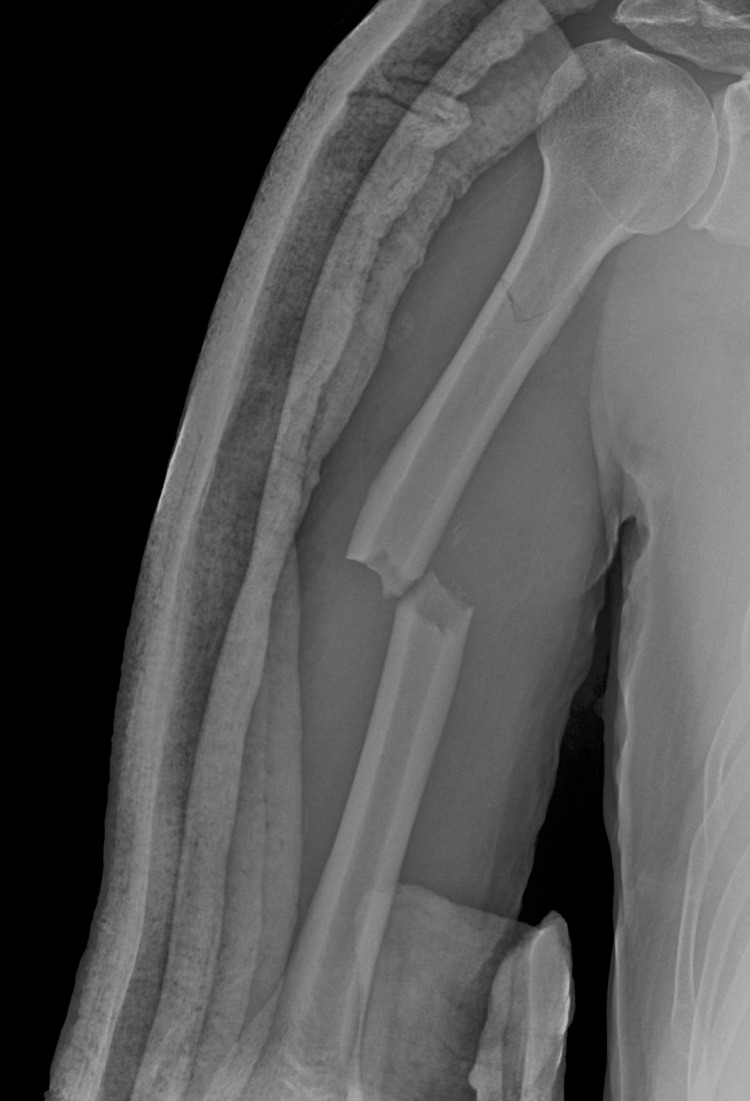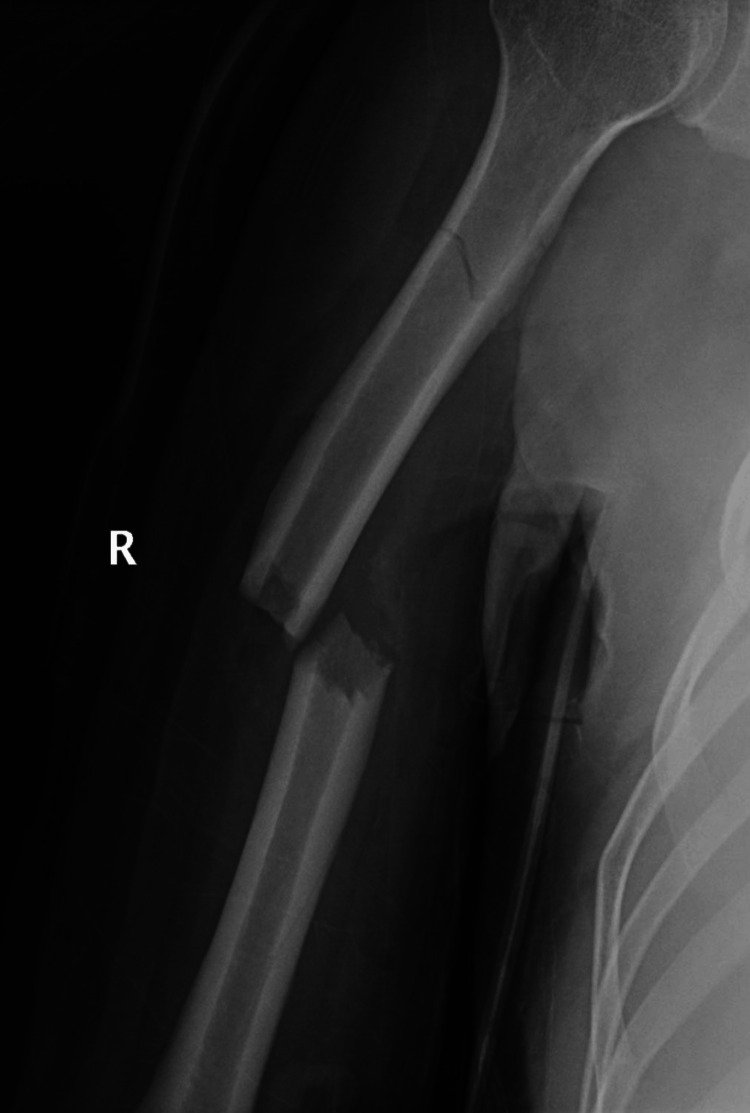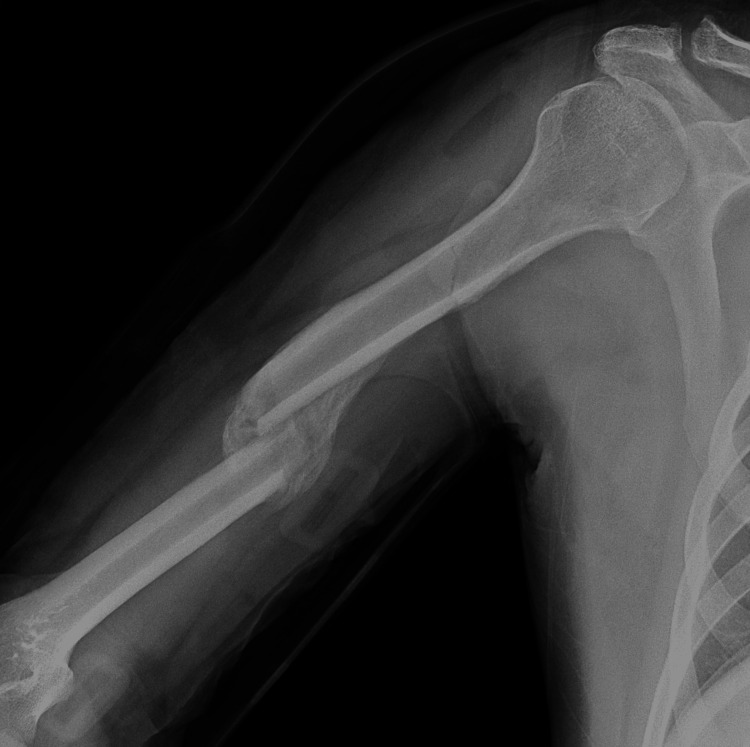Abstract
A 54-year-old male presented with a fractured shaft in the right humerus and refused surgery. The patient was treated with a cast, and a follow-up plain radiography revealed good callus formation after 32 days. The patient had a history of receiving fenugreek seed extract from the first week after the fracture. We did our best to exclude any other factors that helped rapid fracture healing with good callus formation in our patient. The current case supports the hypothesis that fenugreek seed extract promotes bone healing. This hypothesis is supported by a literature review. Previous studies have suggested several mechanisms by which fenugreek promotes bone healing.
Keywords: bony callus, case report, callus formation, fracture healing, trigonella, fenugreek seed
Introduction
Bone fracture management aims to heal a fracture in a good anatomical position within a reasonable time frame. Two factors would affect fracture healing: mechanical and biological [1,2]. Trigonella foenum-graecum, often known as fenugreek, is an annual plant with an extended history of use as a traditional medicine [3]. Fenugreek seeds are useful for treating and preventing different ailments [4]. Flavonoids, such as apigenin 6,8-di-C-glucoside, apigenin-6-C-glucosyl-8-C-galactoside, 6-Cgalactosyl- 8-C-arabinoside, as well as rhaponticin and isovitexin, are the main components of fenugreek seeds. Fenugreek seeds contain phosphorus, which falls into different classes: inorganic phosphorus, phospholipids, phytates, phosphor-proteins, and nucleic acids. Germinated seeds contain amino acids, proteins, ascorbic acid, vitamin E, and sugars [4-7]. A previous study showed that mandibular fracture healing had been accelerated in camels fed fenugreek (100 g/camel/day) for two weeks [3]. However, to our knowledge, no previous study has reported the beneficial effects of fenugreek seeds on fracture healing in humans. This study aimed to report a case in which fenugreek seed extract enhanced the healing of a fracture.
Case presentation
A 54-year-old male had a road traffic accident on May 10, 2023. Patient history showed that the patient was medically free, with no past surgical or medical history, but with chronic sinusitis. The patient weighed 75 kg, had a height of 156 cm, and had a body mass index (BMI) of 30.82. The patient had no history of head trauma or loss of consciousness. Plain radiograph showed a right mid-shaft humerus fracture and a proximal fissure fracture (Figure 1).
Figure 1. Plain radiograph shows right humerus fracture on the day of the accident.
Computed tomography (CT) of the brain, abdomen, and pelvis was unremarkable. CT of the chest showed posterior lung field ground-glass opacity, likely contusion. Laboratory findings showed a normal renal panel and the random blood sugar level was 148 mg/dL (normal 80-140 mg/dL). Complete blood analysis showed a white blood cell count to be 14.8 (normal 4-10) x 103, hemoglobin 14.9 (normal 13-17) g/dL, and platelet count 270 (normal 150-400) x 103 U/L. The patient refused surgical intervention and was asked to undergo conservative treatment with a cast on the injured arm. On follow-up, the plain radiograph on May 21, 2023 (11 days after the fracture) showed that a callus had started to appear (Figure 2).
Figure 2. Plain radiograph shows a right humerus fracture callus starts to appears 11 days after the accident .
On follow-up, a plain radiograph on Jun 11, 2023 (32 days after fracture) showed a large callus formation (Figure 3).
Figure 3. Plain radiograph shows a right humerus callus 32 days after the accident.
The patient's history confirmed regular consumption of fenugreek aqueous seed extract two to three times a day starting from the first week of the fracture.
Discussion
Previous studies have suggested several mechanisms by which fenugreek promotes bone healing. It controls osteogenic markers and increases osteoblast differentiation by raising calcium levels outside of cells and promoting osteoblast differentiation. Experimental studies have shown that it increases osteocalcin and bone morphogenic protein-2 (BMP-2) levels in treated cells. It inhibits tartrate-resistant acid phosphatase (TRAP), prevents proliferation, inhibits invasion, suppresses osteoclastogenesis via inhibition of receptor activator of nuclear factor kappa beta (RANKL/NF-kappaB)-regulated gene expression, exhibits significant DNA damage to osteoclast cells, and enhances apoptosis [6,8]. It contains free amino acids, such as histidine [5] and calcium [9], both of which are important in callus formation and fracture healing [1,2]. Alkaline phosphatase (ALP) participates in the biological processes of fracture healing. Fenugreek stimulates ALP activity in bone marrow-derived stem cells [8,10].
Fenugreek has antihyperglycemic characteristics of type I and type II diabetes in both humans and animals. Research conducted in diabetic rats given alloxan demonstrates that dialyzed fenugreek seed extract exhibits hypoglycemic activity similar to insulin. [5,11]. Gupta et al. reported the results of a double-blind placebo study of patients with type II diabetes mellitus recently diagnosed. The results of their study proved that using fenugreek seeds enhances glucose regulation and decreases insulin resistance [12,13]. Dyslipidemia, characterized by elevated total and low-density lipoprotein cholesterol concentrations, is primarily linked to low bone mass and an increased risk of fracture. Elevated oxidative stress and systemic inflammation linked to dyslipidemia directly cause this impact, raising osteoclastic activity and decreasing bone production. Elevated cholesterol inhibits bone growth and hinders osteoblast development. Therefore, enhanced osteoclastogenesis might be involved in this process. Low high-density lipoprotein C (HDL-C) concentrations have been linked to an inflammatory microenvironment's formation and elevated bone marrow adiposity, which restricts osteoblast differentiation and function and reduces bone mass [14,15]. Experimental studies have shown that fenugreek significantly reduces triglyceride (TG) levels and causes a significant increase in HDL-C levels [13,16].
Different experimental studies have shown that oxidative stress affects osteoblasts, osteoclasts, and osteocytes, causing an imbalance between bone formation and resorption in favor of bone resorption as well as impairing bone mineralization [17-19]. Several studies have suggested fenugreek as a potential antioxidant. Bhatia et al. examined lipid peroxidation and antioxidants in the urine bladders of mice given cyclophosphamide, demonstrating the protective effects of fenugreek on enzymatic antioxidants and lipid peroxidation [20].
Fenugreek's callus-promoting effect in humans is suggested for the first time in this reported case. We did our best to exclude any other factors that helped rapid fracture healing with good callus formation in our patient. No head trauma occurred in our patient. The patient did not receive any biophysical enhancement of fracture healing, such as electromagnetic field or low-intensity pulsed ultrasonography. No systemic therapies, such as teriparatide, calcium, or vitamin D, which might accelerate fracture healing, were given to the patient. [2]. Some side effects were reported after the use of fenugreek, like dyspepsia, abdominal distension, hypersensitivity reactions, cross-reactivity in favism, hypoglycemia, and the risk of bleeding due to the coumarin content. Drinking fenugreek extract in patients receiving some medication should be done with caution as it potentiates the effect of the anticoagulant drug and may reduce potassium serum levels. Additionally, it may increase the hypoglycemic effect of antidiabetic treatment. Its use during pregnancy is not recommended as it may stimulate uterine contractions [9].
This case report has some limitations, and we retrospectively reviewed our case. We could not confirm the recommended dose or duration of fenugreek. In addition, our patient was not assessed for calcium level, vitamin D, or biological markers of bone healing, including serum ALP and osteocalcin. We realize that the evidence level of our case is low; however, it would suggest the need for higher-level evidence from well-planned randomized controlled trials (RCT) that include follow-up of fracture healing using serial radiographs as well as serum bone formation and resorption biomarkers.
Conclusions
This case report suggests the callus-promoting effect of fenugreek seed extract in patients with fractures. However, well-planned randomized controlled trials are required to confirm this effect. Moreover, verification is required for the safe dosage and duration of fenugreek usage. Nevertheless, we were not confronted with any side effects of fenugreek in our patient.
The authors have declared that no competing interests exist.
Author Contributions
Concept and design: Mansour M. Aldhilan, Mohamed E. Abdel-Wanis
Acquisition, analysis, or interpretation of data: Mansour M. Aldhilan, Mohamed E. Abdel-Wanis
Drafting of the manuscript: Mansour M. Aldhilan, Mohamed E. Abdel-Wanis
Critical review of the manuscript for important intellectual content: Mansour M. Aldhilan, Mohamed E. Abdel-Wanis
Supervision: Mansour M. Aldhilan, Mohamed E. Abdel-Wanis
Human Ethics
Consent was obtained or waived by all participants in this study. Health Education and Training Administration (Qassim Health), Kingdom of Saudia Arabia issued approval 607/45/3770
References
- 1.Fracture healing: mechanisms and interventions. Einhorn TA, Gerstenfeld LC. Nat Rev Rheumatol. 2015;11:45–54. doi: 10.1038/nrrheum.2014.164. [DOI] [PMC free article] [PubMed] [Google Scholar]
- 2.Current and future concepts for the treatment of impaired fracture healing. Schlickewei CW, Kleinertz H, Thiesen DM, Mader K, Priemel M, Frosch KH, Keller J. Int J Mol Sci. 2019;20:5805. doi: 10.3390/ijms20225805. [DOI] [PMC free article] [PubMed] [Google Scholar]
- 3.Accelerative effect of fenugreek seeds on the healing of mandibular fracture in male dromedary camels and monitoring of the healing by bone biomarkers. Al-Sobayil FA. J Med Plant Res. 2008;2:92–99. [Google Scholar]
- 4.Recent therapeutic interventions of fenugreek seed: a mechanistic approach. Idris S, Mishra A, Khushtar M. Drug Res (Stuttg) 2021;71:180–192. doi: 10.1055/a-1320-0479. [DOI] [PubMed] [Google Scholar]
- 5.Revisiting Trigonella foenum-graecum L.: pharmacology and therapeutic potentialities. Visuvanathan T, Than LT, Stanslas J, Chew SY, Vellasamy S. Plants (Basel) 2022;11:1450. doi: 10.3390/plants11111450. [DOI] [PMC free article] [PubMed] [Google Scholar]
- 6.Fenugreek (Trigonella foenum-graecum) and its active compounds: a review of its effects on human health through modulating biological activities. Almatroodi SA, Almatroudi A, Alsahli MA, et al. Pharmacogn J. 2021;13:813–821. [Google Scholar]
- 7.Associations between blood antioxidant levels and femoral neck strength. Niu P, Liu Y, Zhang Y, Li L. BMC Musculoskelet Disord. 2023;24:252. doi: 10.1186/s12891-023-06370-5. [DOI] [PMC free article] [PubMed] [Google Scholar]
- 8.Biomolecule from Trigonella stellata from Saudi flora to suppress osteoporosis via osteostromal regulations. Ibrahim HM, Darrag HM, Alhajhoj MR, Khalil HE. Plants (Basel) 2020;9:1610. doi: 10.3390/plants9111610. [DOI] [PMC free article] [PubMed] [Google Scholar]
- 9.Therapeutic uses of fenugreek (Trigonella foenum-graecum L.) Al-Asadi JN. https://www.researchgate.net/profile/Jasim-Al-Asadi/publication/295869478_Therapeutic_Uses_of_Fenugreek_Trigonella_foenum-graecum_L/links/597ef514458515687b49a061/Therapeutic-Uses-of-Fenugreek-Trigonella-foenum-graecum-L.pdf Am J Soc Issues Hum. 2014;2:21–36. [Google Scholar]
- 10.Prognostic significance of alkaline phosphatase activity and callus volume in operatively treated bone fractures. Muljačić A, Majstorović-Matejić M, Guberina M, Živković O, Poljak-Guberina R. Coll Antropol. 2020;10:43–48. [Google Scholar]
- 11.Hypoglycaemic and antihyperglycaemic effects of Trigonella foenum-graecum leaf in normal and alloxan induced diabetic rats. Abdel-Barry JA, Abdel-Hassan IA, Al-Hakiem MH. J Ethnopharmacol. 1997;58:149–155. doi: 10.1016/s0378-8741(97)00101-3. [DOI] [PubMed] [Google Scholar]
- 12.Effect of Trigonella foenum-graecum (fenugreek) seeds on glycaemic control and insulin resistance in type 2 diabetes mellitus: a double blind placebo controlled study. Gupta A, Gupta R, Lal B. https://pubmed.ncbi.nlm.nih.gov/11868855/ J Assoc Physicians India. 2001;49:1057–1061. [PubMed] [Google Scholar]
- 13.The effects of fenugreek on cardiometabolic risk factors in adults: a systematic review and meta-analysis. Khodamoradi K, Khosropanah MH, Ayati Z, Chang D, Nasli-Esfahani E, Ayati MH, Namazi N. Complement Ther Med. 2020;52:102416. doi: 10.1016/j.ctim.2020.102416. [DOI] [PubMed] [Google Scholar]
- 14.Bone health in patients with dyslipidemias: an underestimated aspect. Anagnostis P, Florentin M, Livadas S, Lambrinoudaki I, Goulis DG. Int J Mol Sci. 2022;23:1639. doi: 10.3390/ijms23031639. [DOI] [PMC free article] [PubMed] [Google Scholar]
- 15.Dual effects of lipid metabolism on osteoblast function. Alekos NS, Moorer MC, Riddle RC. Front Endocrinol (Lausanne) 2020;11:578194. doi: 10.3389/fendo.2020.578194. [DOI] [PMC free article] [PubMed] [Google Scholar]
- 16.Effects of fenugreek supplementation on the components of metabolic syndrome: a systematic review and dose-response meta-analysis of randomized clinical trials. Fakhr L, Chehregosha F, Zarezadeh M, Chaboksafar M, Tarighat-Esfanjani A. Pharmacol Res. 2023;187:106594. doi: 10.1016/j.phrs.2022.106594. [DOI] [PubMed] [Google Scholar]
- 17.Role of advanced glycation end-products and oxidative stress in type-2-diabetes-induced bone fragility and implications on fracture risk stratification. Cavati G, Pirrotta F, Merlotti D, Ceccarelli E, Calabrese M, Gennari L, Mingiano C. Antioxidants (Basel) 2023;12:928. doi: 10.3390/antiox12040928. [DOI] [PMC free article] [PubMed] [Google Scholar]
- 18.From estrogen-centric to aging and oxidative stress: a revised perspective of the pathogenesis of osteoporosis. Manolagas SC. Endocr Rev. 2010;31:266–300. doi: 10.1210/er.2009-0024. [DOI] [PMC free article] [PubMed] [Google Scholar]
- 19.Oxidative stress and natural antioxidants in osteoporosis: novel preventive and therapeutic approaches. Marcucci G, Domazetovic V, Nediani C, Ruzzolini J, Favre C, Brandi ML. Antioxidants (Basel) 2023;12:373. doi: 10.3390/antiox12020373. [DOI] [PMC free article] [PubMed] [Google Scholar]
- 20.Aqueous extract of Trigonella foenum-graecum L. ameliorates additive urotoxicity of buthionine sulfoximine and cyclophosphamide in mice. Bhatia K, Kaur M, Atif F, Ali M, Rehman H, Rahman S, Raisuddin S. Food Chem Toxicol. 2006;44:1744–1750. doi: 10.1016/j.fct.2006.05.013. [DOI] [PubMed] [Google Scholar]





